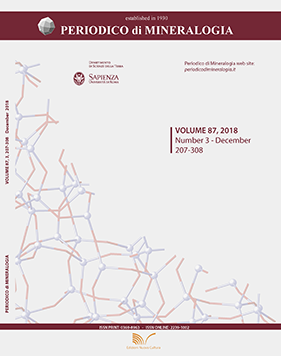Tuhualite revisited: new crystal data and structure refinements on specimens from two localities
DOI:
https://doi.org/10.2451/2018PM807Keywords:
tuhualite, crystal structure, Raman spectroscopy, chain silicate, Mayor Islands, New Zealand, Pantelleria, Italy.Abstract
The crystal structure of tuhualite, ideally NaFe2+Fe3+Si6O15 (Z = 8), has been refined on the basis of modern single-crystal X-ray diffraction data using specimens from its type locality (Mayor Island, New Zealand) and from a new occurrence, Pantelleria (Sicily, Italy). Tuhualite is orthorhombic, space group Cmca, with unit-cell parameters (Mayor Island/Pantelleria) a = 14.3285(8)/14.3786(4), b = 17.2837(10)/17.2098(5), c = 10.1202(6)/10.0991(3) Å, V = 2506.3(3)/2499.05(12) Å3. The crystal structures of both specimens have been refined down to R1 = 0.0506 [on the basis of 1504 reflections with Fo > 4σ(Fo)] and 0.0240 [on the basis of 2280 reflections with Fo > 4σ(Fo)] for the specimens from Mayor Island and Pantelleria, respectively. The main features of the crystal structure of tuhualite as well as the “anomalous” distribution of Fe2+ and Fe3+ cations between the tetrahedral and octahedral sites have been confirmed. Moreover, the occurrence of an additional and partially occupied site within the cavities of the octahedral-tetrahedral framework of tuhualite has been observed in the sample from the type locality, in agreement with the excess of alkaline and alkaline earth metals observed in the available chemical data. New data suggest also the possible occurrence of minor vacancies at the tetrahedral site, following the partial oxidation of ferrous iron to ferric iron and the substitution scheme 3Fe2+ = 2Fe3+ + □. The crystal structure of tuhualite is shown by other natural and synthetic compounds. Among natural phases, tuhualite has isotypic relationships with zektzerite and emeleusite. These three phase form the tuhualite group. The micro-Raman spectrum of tuhualite has been collected and compared with those of the other members of the tuhualite group.Downloads
Published
2018-12-14
Issue
Section
MINERALOGY and CRYSTALLOGRAPHY


